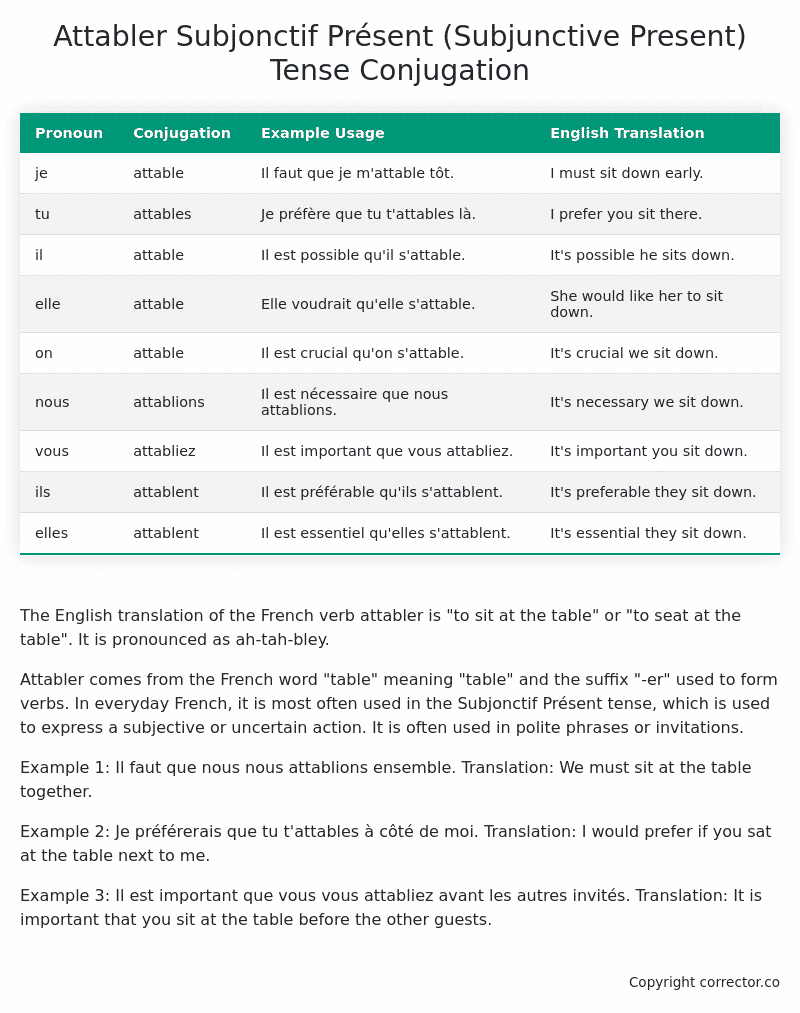Subjonctif Présent (Subjunctive Present) Tense Conjugation of the French Verb attabler
Introduction to the verb attabler
The English translation of the French verb attabler is “to sit at the table” or “to seat at the table”. It is pronounced as ah-tah-bley.
Attabler comes from the French word “table” meaning “table” and the suffix “-er” used to form verbs. In everyday French, it is most often used in the Subjonctif Présent tense, which is used to express a subjective or uncertain action. It is often used in polite phrases or invitations.
Example 1:
Il faut que nous nous attablions ensemble.
Translation: We must sit at the table together.
Example 2:
Je préférerais que tu t’attables à côté de moi.
Translation: I would prefer if you sat at the table next to me.
Example 3:
Il est important que vous vous attabliez avant les autres invités.
Translation: It is important that you sit at the table before the other guests.
Table of the Subjonctif Présent (Subjunctive Present) Tense Conjugation of attabler
| Pronoun | Conjugation | Example Usage | English Translation |
|---|---|---|---|
| je | attable | Il faut que je m’attable tôt. | I must sit down early. |
| tu | attables | Je préfère que tu t’attables là. | I prefer you sit there. |
| il | attable | Il est possible qu’il s’attable. | It’s possible he sits down. |
| elle | attable | Elle voudrait qu’elle s’attable. | She would like her to sit down. |
| on | attable | Il est crucial qu’on s’attable. | It’s crucial we sit down. |
| nous | attablions | Il est nécessaire que nous attablions. | It’s necessary we sit down. |
| vous | attabliez | Il est important que vous attabliez. | It’s important you sit down. |
| ils | attablent | Il est préférable qu’ils s’attablent. | It’s preferable they sit down. |
| elles | attablent | Il est essentiel qu’elles s’attablent. | It’s essential they sit down. |
Other Conjugations for Attabler.
Le Present (Present Tense) Conjugation of the French Verb attabler
Imparfait (Imperfect) Tense Conjugation of the French Verb attabler
Passé Simple (Simple Past) Tense Conjugation of the French Verb attabler
Passé Composé (Present Perfect) Tense Conjugation of the French Verb attabler
Futur Simple (Simple Future) Tense Conjugation of the French Verb attabler
Futur Proche (Near Future) Tense Conjugation of the French Verb attabler
Plus-que-parfait (Pluperfect) Tense Conjugation of the French Verb attabler
Passé Antérieur (Past Anterior) Tense Conjugation of the French Verb attabler
Futur Antérieur (Future Anterior) Tense Conjugation of the French Verb attabler
Subjonctif Présent (Subjunctive Present) Tense Conjugation of the French Verb attabler (this article)
Subjonctif Passé (Subjunctive Past) Tense Conjugation of the French Verb attabler
Subjonctif Imparfait (Subjunctive Imperfect) Tense Conjugation of the French Verb attabler
Subjonctif Plus-que-parfait (Subjunctive Pluperfect) Tense Conjugation of the French Verb attabler
Conditionnel Présent (Conditional Present) Tense Conjugation of the French Verb attabler
Conditionnel Passé (Conditional Past) Tense Conjugation of the French Verb attabler
L’impératif Présent (Imperative Present) Tense Conjugation of the French Verb attabler
L’infinitif Présent (Infinitive Present) Tense Conjugation of the French Verb attabler
Struggling with French verbs or the language in general? Why not use our free French Grammar Checker – no registration required!
Get a FREE Download Study Sheet of this Conjugation 🔥
Simply right click the image below, click “save image” and get your free reference for the attabler Subjonctif Présent tense conjugation!

Attabler – About the French Subjonctif Présent (Subjunctive Present) Tense
Formation of the Subjonctif Présent
Common Everyday Usage Patterns
Interactions with Other Tenses
Summary
I hope you enjoyed this article on the verb attabler. Still in a learning mood? Check out another TOTALLY random French verb conjugation!


